In the Part 1 of this 4 part series, we had an in depth look at importing your images from your camera into your Lightroom catalog.
We looked at how by applying presets and folder structures we could start to create an easy to navigate image storage solution. In this second part of the series we are going to be looking at how to organize your images once they are into the Lightroom catalog. This is a very personal process and one which will require you to create your own organization structure.
Upon import into the Lightroom catalog there are 4 different ways I find really helpful for organizing my images; Collections, Flags, Ratings and Labels. You may choose to use any combination of the 4 to create an organization system that is intuitive to you. The first way of image organization that we will look at is Collections.
Collections
Collections within Lightroom come in two distinct types; Collections and Smart Collections.
Smart collections are an ever changing type of collection that are based upon a set user designated criteria. Smart Collections can be set to automatically collect images with a single of combination of specific EXIF or IPTC data fields. For example I could create a smart collection with the criteria that City must equal Luang Prabang.
As a travel photographer I prefer to have my smart collections setup to sort by location …
Once created this will then collect all my images that I have added Luang Prabang to the City field of the IPTC data. Collections on the other hand are the same as smart collections except that it is 100% manual. Rather than selecting an IPTC or EXIF field to sort by, you have to drag and drop the images into each collection.
Smart collections have the advantage of automatically sorting the images upon import if you add a metadata preset when you import them. As a travel photographer I prefer to have my smart collections setup to sort by location so that I can easily find images from a specific location or city. However there are a multitude of ways of organising your images and Lightroom allows you to organize by pretty much any combination of criteria.
The most common options would be File Type, Flags, Ratings, Aperture, Lens or even Job Identifier (such as clients name).
How to set up smart collections
1) Right click in the collections pane and select ‘Create Smart Collection
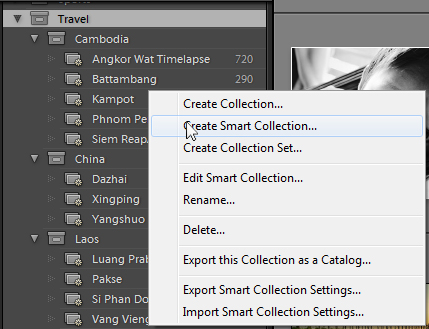
2) When the pop-up window appears insert a name for you smart collection into the N‘ field and then selected where you would like the Smart Collection to go. I use collection sets with the individual country names and then place each location into it’s respective country
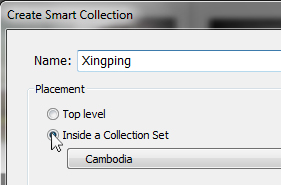
3) Next step is to select how you want the rules you create to work. The default option is all and this means that you search will only give results that are equal to your exact search criteria. You can also choose from a‘ which means that it will give images that abide by any of the rules that you choose below. Finally by selecting none you will be searching for images which don’t meet the criteria you select.
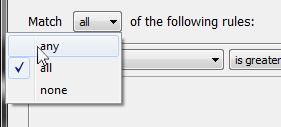
4) We know have to move onto creating the specific rules for you smart collections to work

5) The first step of creating the rules is to select what EXIF or IPTC data field you wish to filter the images by. For this example I will be using City and Country. However you can choose from a whole host of options such as Has adjustments, Rating or Copyright Status
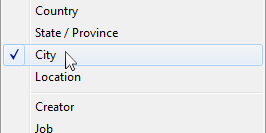
6) The next step is crucial to making sure that all the images in your collection will be added to the collection.
- is – only returns images where criteria is exactly the same as specified
- is not – only returns images which don’t match the criteria exactly
- contains – returns images that have part of whole of the search criteria
- contains all – returns images that contain the whole of the search criteria, may contain extra words
- contains words – is an AND search so if you are looking for ‘Luang Prabang’ it would return all the items that contain the whole words ‘Luang’ and ‘Prabang’
- doesn’t contain – returns images that don’t contain the search criteria at all
- starts with – returns images that have the search criteria text at the start
- ends with – returns images that have the search criteria text at the end
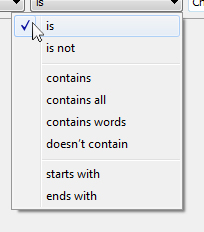
7) The final step is to specify the search criteria. This will be completely dependent on the options you have selected in the above steps
![]()
Flags
Flags are the first step in my image organization triangle (Flags, Labels and Ratings). Flags come in three types; White Flag (Picked), Black Flag (Rejected) and Unflagged, which have the shortcuts [P], [X] and [U] respectively. I implement flags as a first cull method. I spend time going through my recently imported images and either Pick or Reject them.
The picked images go forward to be rated, labelled and edited whereas the rejected images remain untouched. I only tend to reject images that are wildly over exposed or blurred, this is not the step for culling out bad composition etc.
The one thing I stress is to never delete images. Improvements in editing software or important events in the future may mean that images that are useless to you now make become useful in the future. Memory is so cheap, that there is no reasonable reason to delete any images.
The only downside to flags and the reason why I don’t use them solely is that they are not embedded into the metadata. If in the future you lose your Lightroom catalog it will mean that you would have to go back and re-flag all your images again.
Ratings
I tend to be a little bit of a perfectionist and personally my brain works on two levels; Good images and bad images. I very rarely find a middle ground and so when implementing this rating scheme it forced me to change how I think about and approach this process. For this reason I suggest you spend time creating a set method that you stick to, otherwise the rating system will be more of a hindrance than a help.
My rating system works like this:
- No Stars – Awaiting Review
- 1 Star – Not for processing
- 2 Stars – Not for processing (Second Review in the future)
- 3 Stars – Processing for clients
- 4 Stars – Processing for blog posts and online use
- 5 Stars – Portfolio Images
Labels
Labels are very similar in principle to Rating except that they use specific Colors instead of stars. Labels come in 5 Colors; Red, Yellow, Green, Blue and Purple. Within Lightroom I use labels less frequently that Ratings and Flags. I use them in system for specific targeting of my images once they are in Lightroom and have been rated and flagged.
I use the Colors to create mini-sub groups inside of the collections to selected images for specific blog posts etc. For example when selecting images for my blog post Reflection: 2012, I filtered the images inside my travel collections down to 5 star images and then selected my favorite images.
I then designated them with a purple label.
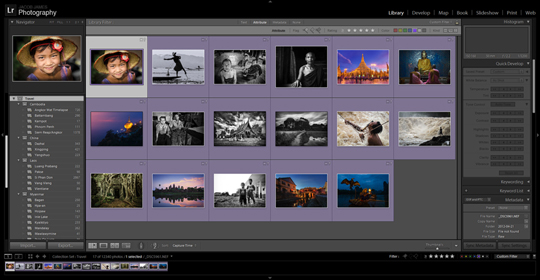
This allows me to quickly see the images together and assess how they work well in a set. I also often use this method when submitting photo stories, as it allows me to see them as a panel and assess if they have a consistent style etc much more easily. Labels can be added to you images by two methods. The first is to right click the image and select Color Label and then select from the drop-down menu. This can be quite slow and tedious if you have a few images to label.
For this reason I prefer to use the keyboard shortcuts:
- Shift + 6 – Red
- Shift + 7 – Yellow
- Shift + 8 – Green
- Shift + 9 – Blue
Where is the purple you may ask? This is a question many people have asked and it seems like Adobe don’t have an answer either. If you want to label something purple unfortunately the only way appears to be via the right click method.
Filtering based on tags
Flags, Ratings and Labels are extremely powerful tools in Lightroom. Once you have spent the time tagging all you images with the various labels and flags you will quickly be able to locate images with specific tags. Using the filter bar at the top and bottom of the Library pane you can search by any one or a combination of tags on your images. If you combine this with an effective collection strategy you can for example quickly search ‘Portfolio Quality (5 Star images), used in my reflection post, shot in Siem Reap, Cambodia’ with a few simple clicks.
![]()
If you only have a small image collection you may not see how this would benefit you but starting this correctly will inevitably save you many hours in the future when your image collection has grown to 10-100,000s of images.
By now you should begin understanding how to organize your images upon import and also within the Lightroom catalog to create an easy to navigate and efficient workflow that will save you a lot of time in the future.
Next, in Part 3 we’ll look at editing your images within Lightroom and how that relates to the quality of your image.


